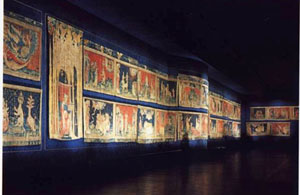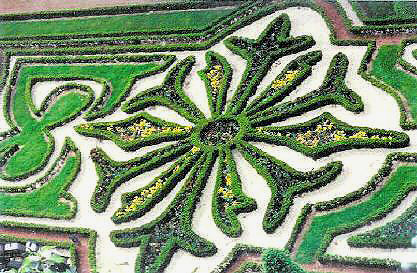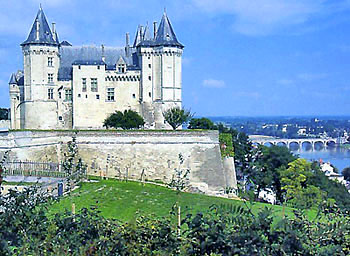 |
| The Independent Traveler's Newsletter PAGE THREE |
 |
| The Independent Traveler's Newsletter PAGE THREE |
| CHÂTEAUX ~
TREASURES OF THE LOIRE . . . in
France's Valley of the Kings Western Loire  There are so many unique and beautiful châteaux in the Loire Valley that it is difficult to limit our recommendations to only a few. Perhaps some of these will pique your interest. We we will begin with one that shouldn't be missed: Château des Ducs de Bretagne in Nantes. This part of France was once Brittany (now the Pays de la Loire), and the château of the Dukes of Brittany is now a museum. Built in 1207 on the Gallo-Roman wall still visible in the city of Nantes, the first castle was rebuilt in 1466 giving way to the present monument. This change was the work of François II, the last duke of then independent Brittany whose goal was to make the castle a defensive fortress. Duchess Anne, Queen of France by successive marriages to Charles VII and Louis XII, embellished the château ~ sculpted decorations and other features mark the influences of the Italian Renaissance. Once Brittany became part of France in 1532, the castle became the Logis Breton of the Kings of France, then barracks, a military arsenal and a prison. There was a fire in 1670, construction projects in the 1700s and an explosion in 1800. Transformations to repair and reconstruct the castle continued until, in 1862, it was classified an historic monument and then sold by France to the city of Nantes in 1915. In 1924 it became a municipal museum. During World War II German troops occupied it and built a bunker. Visitors will enjoy the vast collections in the museum, and there is a fine café/restaurant in the Château as well. Information about hours and entrance fees can be found by clicking on the link above.  At
the confluence of the River Loire and River Maine in the département of
Maine-et-Loire is
the city of Angers. It is peaceful and very French ~ in fact, it
is said that this, the Anjou region and eastern Pays de la Loire, is
where the most perfect French, free of any patois, is spoken. At
the confluence of the River Loire and River Maine in the département of
Maine-et-Loire is
the city of Angers. It is peaceful and very French ~ in fact, it
is said that this, the Anjou region and eastern Pays de la Loire, is
where the most perfect French, free of any patois, is spoken. It is here you will find the Château d'Angers, entered by a drawbridge and built in the 1230s in the first decade of Louis IX. Originally, it had seventeen towers that rose 35 feet higher than the wall, but in the late 16th century they were made level with the wall. Louis succeeded his father, Louis VIII, and as he was a minor, it is believed that the regent, Blanche de Castille, initiated the massive project. The castle stands on the banks of the river and was intended as a defensive structure and not a residence. Louis VIII left the county of Anjou to his son Charles, founder of the House of Anjou of the Capetian dynasty. The Angevin dynasty spread as far and wide as Hungary and Sicily and was very powerful. One of the main attractions at Château d'Angers is the 14th century wool Tapestry of the Apocalypse about 100 meters in length and a priceless treasure. It was created by the Parisian weaver Nicolas Bataille and painter Hennequin de Bruges commissioned by Louis I (son of Jean le Bon) in 1373. On January 10, 2009, the castle suffered severe damage from an electrical fire. The Logis Royal, which houses the tapestry and valuable documents as well as administrative offices, was heavily damaged with 4300 square feet of the roof destroyed. Miraculously, the tapestry (actually it is many displayed as one) was not harmed but the devastation was estimated at two million euros. Louis II added the chapel between 1405 and 1412, and had apartments built for the royal family. The chapel is called Sainte Chapelle, the name given any church (such as the one in Paris) that has a relic of the Passion enshrined ~ here it is a splinter of the True Cross given by Louis IX.    The tapestry, chapel and the
beautiful
gardens.
 The Château de Saumur, also in the Maine-et-Loire département, is our next stop along the River Loire. The original castle on this site dated from the 10th century, constructed by Theobold I, Count of Blois, as a fortification against the Normans. In 1025 it came into the hands of Foulque Nerra (970-1040), Count of Anjou, who bequeathed it to his Plantagenet heirs. He is considered the first great builder of Medieval castles, having built approximately 100 in the Loire. It was destroyed in 1067. It wasn't until the early 13th century that Philippe August reclaimed Anjou from the King of England, resulting in the construction of both Angers and Saumur fortress castles beside the Loire. The Saumur castle was used as a prison during the 17th and 18th centuries, and from 1780 mostly imprisoned British sailors. It was, thankfully, spared during the French Revolution and later saved from destruction by decision of Napoleon I who turned it into a state prison. Restoration of the monarchy brought a new destiny to Saumur; in 1814 the Ministry of War took control of the château, and it became a weapons and munitions depot. The military finally departed in 1889, and the city of Saumur worked with the State to restore the castle and create a municipal museum. The city acquired Château de Saumur in 1906 and began restoration. The partially-completed monument opened to the public in 1912 with a museum of decorative and fine arts on the first floor of the North wing. The Horse museum is on the second floor. The château was closed for a long period of time for restoration work and reopened in 2012.  Speaking of horses, the City of Saumur has two other distinctive claims to fame. First is the French National Horse-Riding School, created in 1972, that trains the most elite riders. Backed by a research program and documentation center, the Cadre Noir, the teaching body of the school, contributes fully to the renown of French horsemanship. But the riding school has much older roots than the 20th century. At the end of the 16th century, Duplessis Mornay founded a protestant university in Saumur, and a horsemanship academy was managed here by M. de Saint-Vual. King Louis XV assigned the Duke of Choiseul to reorganize the French cavalry, and 'the finest school in the world' came into being on the Place du Chardonnet. It remained in operation until 1788.  The second is champignons ~ mushrooms. Saumur has been a commercial mushroom-producing center for over 100 years. They are grown in troglodyte caves throughout the area where they have most likely grown since the 15th century. A wide variety of mushrooms can be found here including button, oyster, blue foot and shiitake. Don't miss the chance to visit the Mushroom Museum (le Musée de Champignon) while in Saumur. Central Loire   Follow the Loire eastward until you reach the fork of the Vienne, and bear left to stay along the Loire. Bear right to follow the Indre River and you will soon come to Château d'Ussé, a fairytale castle on the right bank, said to have inspired Charles Perrault to write the story of Sleeping Beauty. It is now commonly referred to as 'Sleeping Beauty's castle'. We remember walking along the outside and peering in windows to see scenes of Sleeping Beauty and the Prince. This may be the most romantic of all the châteaus in France that are open to the public. It is exquisitely decorated and furnished and perhaps on of the finest examples of the use of tuffeau stone. The château is privately owned and a bit more expensive to visit than the State-owned châteaux, but we think it is worth it. The rooms open to the public are staged with life-size wax figures. However, because of the many stairways, especially the steeper one to Sleeping Beauty's tower, it may not be ideal for small children or older folks. You are now in the département of Indre-et-Loire in the region known as Centre Val-de-Loire ~ also known generally as the Touraine ~ and whose capital is Orléans. It is popular with Parisians who can live here and take the one-hour TGV into Paris to work. Well-known for its wine production, it is also the home of many beautiful châteaux such as Amboise, Azay-le-Rideau, Chenonceau, Chinon, Langeais, Loches and Villandry. Directly south of Ussé along the River Vienne is Château de Chinon. Not long ago this castle was but a ruin of its former self. Today, after years of restoration, it is once again worthy of a visit. Its history begins in the 5th century in Gallo-Roman times. Centuries later, Theobald I, Count of Blois, the very same who constructed and fortified Château de Saumur, used it as a stronghold. Foulque Nerra III, Count of Anjou, captured Château de Langeais and then Chinon about 22 kilometers away. In 1044, Geoffrey Plantagenet was recognized as owner of Chinon, Langeais and Tours, and from that time until the beginning of the 13th century these passed down to his heirs.  Château de Chinon before and after 21st century restoration as seen from the donjon  Returning north to the Indre River and just past Château d'Ussé, we discover the beauty of Château d'Azay-le-Rideau. The original Medieval fortress castle from the 12th century was the scene of a fierce battle between Burgundian and Armagnac factions during the Hundred Years War and was burned to the ground. In 1518 it came into the possession of Gilles Berthelot, Mayor of Tours and Treasurer General of the King's finances, who was seeking a suitable residence to reflect his wealth and success. He began to rebuild the castle maintaining its Medieval history while incorporating Italian Renaissance architecture. Rebuilding was a tedious task as the ground was wet and a firm foundation had to be engineered. By 1527, the structure was still incomplete. Gilles cousin, Jacques de Beaune was executed; he had also been involved in the King's finances, and Gilles was forced to flee fearing his own mishandling of the money would be discovered. He died two years later. François I took the château against the pleas of Gilles' wife, and gave it to Antoine Raffin, one of his knights at arms in 1535. He made only minor changes leaving the château unfinished and the two Medieval wings unchanged. They were demolished in the 7th century. It remains this way today. Azay's most remarkable feature is its internal staircase. Its straight flights were inspired by Châteaudun, and although similar staircases can be found in other châteaux, Azay's is the oldest surviving example. The interior stone work is exceptional, and visitors will enjoy wandering from room to room to see some fine Flemish tapestries in the great hall and throughout the château, apartments in the neo-Renaissance style, and the pediment with François I symbol, the Salamander.   Once more along the Loire River are the châteaux of Langeais, Le Réaux, and Villandry. Château de Langeais' claim to fame is that it was the site of the marriage of Charles VIII and Anne de Bretagne in 1491. It also has a well-preserved Keep built by the ever-present Foulque Nerra. Château le Réaux is an attractive structure built with a mixture of brick and stone in the 16th century with an 18th century wing. It is privately owned and is a luxury bed and breakfast ~ we had the pleasure of staying there many years ago. Unfortunately, at this time, it seems that there are technical issues precluding visits by the public or booking rooms. We would like to focus on the third château we mentioned: Château de Villandry.  This grand château began as a little château called Colombiers that was acquired by Jean le Breton in 1533. He rebuilt it almost completely and renamed it Villandry. He was an important government official having been recently appointed Comptroller of Wars. His other château no longer was suitable to his prosperity, and he had more than enough fortune to proceed with this large endeavor. He did save the tower and right wing of Colombiers, both of which preserved the antiquity of the site. Comte Michel-Ange de Castellane acquired Villandry in 1754 and proceeded with major construction. Some of this was removed by the next owner in the early 1900s claiming to restore the building to its original state, but the grand 18th century staircase was left standing. Read more about this châtelain below . . . Château de Villandry has, in our opinion, the most magnificent gardens of any château in France. These vast and intricate French gardens are certainly the main attraction, although gardens existed here since the 16th century. But when Dr. Joachim Carvallo visited Villandry in 1906, he acquired the château and set about to do something about its gardens. At that time, there were romantic English gardens and lawn-covered hillocks which were not to his taste. In 1908, after having completed restoration to the château, he decided to recreate its Renaissance gardens. He was a scientist, and his knowledge influenced his approach through the use of literary and archeological clues, which gave him the idea of a truly Renaissance landscape. He hired a Spanish painter and the Spanish landscape architect Javier de Winthuysen to design gardens called the salon of the crosses and the salon of love. He himself designed the salon of music. For the 18th century classical water garden he reverted to the Marquis de Castellane's plans that had been preserved in the Napoleonic land register. The layout and the choice of vegetables was planned to return to the origins of a Renaissance formal garden. His descendants have preserved the estate in every detail. In the 1970s an herb garden was added. In 2008, to celebrate the centenary of his work on the gardens, the sun garden based on Dr. Carvallo's design was added. Finally, in 2009, the family decided to move to organic, especially in the kitchen garden, ending the use of pesticides. The château and gardens are open year 'round for visitors.     The
Art Gallery, Dining Room, and gardens at Château de Villandry
continued
on page 4
|